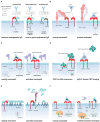Expression, Role, and Regulation of Neutrophil Fcγ Receptors
- PMID: 31507592
- PMCID: PMC6718464
- DOI: 10.3389/fimmu.2019.01958
Expression, Role, and Regulation of Neutrophil Fcγ Receptors
Abstract
Neutrophils are best known for their critical role in host defense, for which they utilize multiple innate immune mechanisms, including microbe-associated pattern recognition, phagocytosis, production of reactive oxygen species, and the release of potent proteases, mediators, antimicrobials, and neutrophil extracellular traps. Beyond their well-established contribution to innate immunity, neutrophils were more recently reported to interact with various other cell types, including cells from the adaptive immune system, thereby enabling neutrophils to tune the overall immune response of the host. Neutrophils express different receptors for IgG antibodies (Fcγ receptors), which facilitate the engulfment of IgG-opsonized microbes and trigger cell activation upon cross-linking of several receptors. Indeed, FcγRs (via IgG antibodies) confer neutrophils with a key feature of the adaptive immunity: an antigen-specific cell response. This review summarizes the expression and function of FcγRs on human neutrophils in health and disease and how they are affected by polymorphisms in the FCGR loci. Additionally, we will discuss the role of neutrophils in providing help to marginal zone B cells for the production of antibodies, which in turn may trigger neutrophil effector functions when engaging FcγRs.
Keywords: B cells; Fcγ receptors; IgG; immune complexes; neutrophils.
Figures

Similar articles
-
Human neutrophil Fc gamma receptors: different buttons for different responses.J Leukoc Biol. 2023 Nov 24;114(6):571-584. doi: 10.1093/jleuko/qiad080. J Leukoc Biol. 2023. PMID: 37437115 Review.
-
The Regulatory Effects of Interleukin-4 Receptor Signaling on Neutrophils in Type 2 Immune Responses.Front Immunol. 2019 Oct 24;10:2507. doi: 10.3389/fimmu.2019.02507. eCollection 2019. Front Immunol. 2019. PMID: 31708926 Free PMC article. Review.
-
Diversification of IgG effector functions.Int Immunol. 2017 Jul 1;29(7):303-310. doi: 10.1093/intimm/dxx025. Int Immunol. 2017. PMID: 28472280 Free PMC article. Review.
-
Differential role of neutrophil Fcgamma receptor IIIB (CD16) in phagocytosis, bacterial killing, and responses to immune complexes.Arthritis Rheum. 2002 May;46(5):1351-61. doi: 10.1002/art.10230. Arthritis Rheum. 2002. PMID: 12115243
-
Fcγ receptor pathways during active and passive immunization.Immunol Rev. 2015 Nov;268(1):88-103. doi: 10.1111/imr.12343. Immunol Rev. 2015. PMID: 26497515 Free PMC article. Review.
Cited by
-
Neutrophils bearing adhesive polymer micropatches as a drug-free cancer immunotherapy.Nat Biomed Eng. 2024 May;8(5):579-592. doi: 10.1038/s41551-024-01180-z. Epub 2024 Feb 29. Nat Biomed Eng. 2024. PMID: 38424352
-
Improving Antibody Therapeutics by Manipulating the Fc Domain: Immunological and Structural Considerations.Annu Rev Biomed Eng. 2022 Jun 6;24:249-274. doi: 10.1146/annurev-bioeng-082721-024500. Epub 2022 Apr 1. Annu Rev Biomed Eng. 2022. PMID: 35363537 Free PMC article. Review.
-
Persistent and transient olfactory deficits in COVID-19 are associated to inflammation and zinc homeostasis.Front Immunol. 2023 Jul 14;14:1148595. doi: 10.3389/fimmu.2023.1148595. eCollection 2023. Front Immunol. 2023. PMID: 37520523 Free PMC article.
-
Accumulation of Neutrophil Phagocytic Antibody Features Tracks With Naturally Acquired Immunity Against Malaria in Children.J Infect Dis. 2023 Sep 15;228(6):759-768. doi: 10.1093/infdis/jiad115. J Infect Dis. 2023. PMID: 37150885 Free PMC article.
-
Redefining CRP in tissue injury and repair: more than an acute pro-inflammatory mediator.Front Immunol. 2025 Feb 28;16:1564607. doi: 10.3389/fimmu.2025.1564607. eCollection 2025. Front Immunol. 2025. PMID: 40093010 Free PMC article. Review.
References
-
- Fliedner TM, Cronkite EP, Killmann SA, Bond VP. Granulocytopoiesis. II. emergence and pattern of labeling of neutrophilic granulocytes in humans. Blood. (1964) 24:683–700. - PubMed

